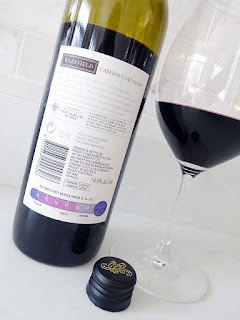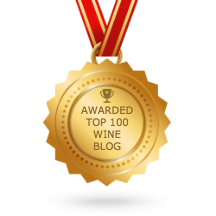red wine review is a lovely Agiorgitiko from Greece that made its debut at the LCBO earlier this month in the LCBO VINTAGES New Release Collection as an Online & Flagship Exclusive - with many bottles still available for purchase both online and in 20 stores in the Greater Toronto and Ottawa areas.
It is produced by Domaine Skouras, a well-known and highly-regarded winery that was established by George Skouras within the small village of Pyrgela, on the outskirts of his hometown of Argos in Nemea of northeastern Peloponnese. After studying oenology in Dijon (Burgundy), George had a long-standing vision to create a winery in his homeland with the goal of producing high-quality wines - a vision that was realized in 1986.
Today, Domaine Skouras resides in the highlands of Argolida, within the village of Malandreni in Nemea. The ultra-modern winery was built in 2004 in the Nemea winegrowing zone, which is Greece's largest and possibly the most exciting Protected Designation of Origin (PDO) for red wines. The new facility offered greater capacity and cutting-edge infrastructure, and was carefully designed to preserve the authenticity and identity of the wines. The winery is situated among vineyards in an area that is blessed with ideal conditions for viticulture, especially for the indigenous Agiorgitiko.
The family-owned winery continues to be energetically and passionately run by George and his wife, Ourania. They are also joined by their son and daughter, Dimitris and Stella, respectively, who share their vision for the Domaine. Dimitris studied Viticulture and Oenology in France, while Stella is a graduate of Economics and Marketing studies in Scotland.
At Domaine Skouras, the philosophy is based on every wine expressing a clear and consistent philosophy, which is distilled into four key principles: purity, varietal clarity, expression of the mesoclimate, true reflection of the terroir. The vineyard team works to produce exceptional grapes with an unwavering and uncompromising dedication, and constant observation. Technology, for the Skouras team, is simply a tool for precision and control, as true winemaking happens with minimal intervention, and by respecting the grape, the land, and the passage of time.
This red wine is crafted with 100% Agiorgitiko that was grown at their vineyard in Corinthia at the high altitude of 3,412 feet (1,039 metres), from vines averaging 30 years old and planted on red clay soils rich in minerals. The vineyard was first planted in 1970, while the first vintage for this wine was 1989. After harvesting the grapes in October, they arrived at the winery and underwent alcoholic fermentation and extraction in stainless steel vats, with post-fermentation extraction occurring for 14 days. This was followed by full malolactic fermentation in oak barriques. The wine was matured for 12 months in new French barriques, with 4 of these months in the presence of light lees, then underwent further maturation in bottle for 6 months in their cellar prior to release. Let's see how this 2022 Agiorgitiko from Greece is tasting tonight...
The medium+ intensity nose takes some coaxing to reveal plummy, raspberry, and blackberry aromas with a sheen of woody oak, followed by minerals, savoury earth, and dark red berries. The medium+ to medium-full bodied palate is dry with ripe plum, raspberry, cherry, sandalwood, dark red berry, mineral, and spice flavours supported by fresh, crisp, and lively acidity. The mid-palate is crunchy with fine-grained and well-structured tannins. There's some youthful grip on the back-palate. Savoury, smoky, and stony mineral notes linger on the long, crisp finish. Enjoyable now, but will be even better after a few years in the cellar. Highly recommended buy! Score: 92 pts
Many other fine wines by Domaine Skouras are available at the LCBO and through their Agent - Kolonaki Fine Wines & Spirits.
It is produced by Domaine Skouras, a well-known and highly-regarded winery that was established by George Skouras within the small village of Pyrgela, on the outskirts of his hometown of Argos in Nemea of northeastern Peloponnese. After studying oenology in Dijon (Burgundy), George had a long-standing vision to create a winery in his homeland with the goal of producing high-quality wines - a vision that was realized in 1986.
Today, Domaine Skouras resides in the highlands of Argolida, within the village of Malandreni in Nemea. The ultra-modern winery was built in 2004 in the Nemea winegrowing zone, which is Greece's largest and possibly the most exciting Protected Designation of Origin (PDO) for red wines. The new facility offered greater capacity and cutting-edge infrastructure, and was carefully designed to preserve the authenticity and identity of the wines. The winery is situated among vineyards in an area that is blessed with ideal conditions for viticulture, especially for the indigenous Agiorgitiko.
The family-owned winery continues to be energetically and passionately run by George and his wife, Ourania. They are also joined by their son and daughter, Dimitris and Stella, respectively, who share their vision for the Domaine. Dimitris studied Viticulture and Oenology in France, while Stella is a graduate of Economics and Marketing studies in Scotland.
At Domaine Skouras, the philosophy is based on every wine expressing a clear and consistent philosophy, which is distilled into four key principles: purity, varietal clarity, expression of the mesoclimate, true reflection of the terroir. The vineyard team works to produce exceptional grapes with an unwavering and uncompromising dedication, and constant observation. Technology, for the Skouras team, is simply a tool for precision and control, as true winemaking happens with minimal intervention, and by respecting the grape, the land, and the passage of time.
This red wine is crafted with 100% Agiorgitiko that was grown at their vineyard in Corinthia at the high altitude of 3,412 feet (1,039 metres), from vines averaging 30 years old and planted on red clay soils rich in minerals. The vineyard was first planted in 1970, while the first vintage for this wine was 1989. After harvesting the grapes in October, they arrived at the winery and underwent alcoholic fermentation and extraction in stainless steel vats, with post-fermentation extraction occurring for 14 days. This was followed by full malolactic fermentation in oak barriques. The wine was matured for 12 months in new French barriques, with 4 of these months in the presence of light lees, then underwent further maturation in bottle for 6 months in their cellar prior to release. Let's see how this 2022 Agiorgitiko from Greece is tasting tonight...
Tasting Note:
DOMAINE SKOURAS GRANDE CUVÉE AGIORGITIKO 2022 - PDO Nemea, Greece (#94706) (XD) - $42.95The medium+ intensity nose takes some coaxing to reveal plummy, raspberry, and blackberry aromas with a sheen of woody oak, followed by minerals, savoury earth, and dark red berries. The medium+ to medium-full bodied palate is dry with ripe plum, raspberry, cherry, sandalwood, dark red berry, mineral, and spice flavours supported by fresh, crisp, and lively acidity. The mid-palate is crunchy with fine-grained and well-structured tannins. There's some youthful grip on the back-palate. Savoury, smoky, and stony mineral notes linger on the long, crisp finish. Enjoyable now, but will be even better after a few years in the cellar. Highly recommended buy! Score: 92 pts
Many other fine wines by Domaine Skouras are available at the LCBO and through their Agent - Kolonaki Fine Wines & Spirits.






































